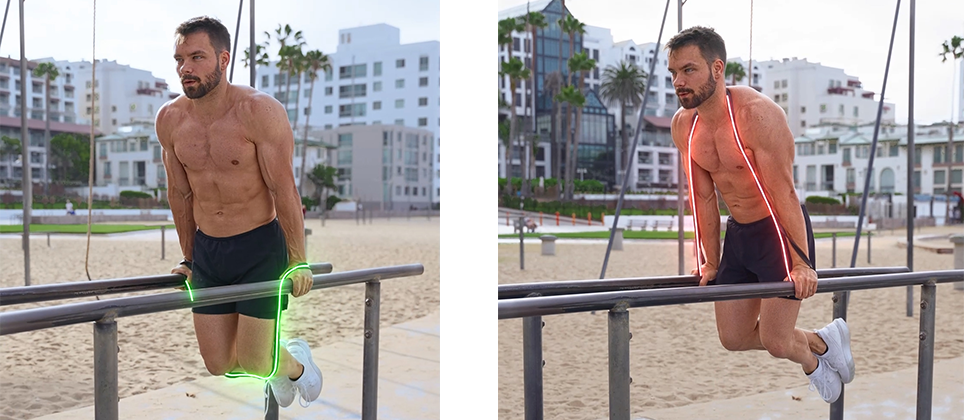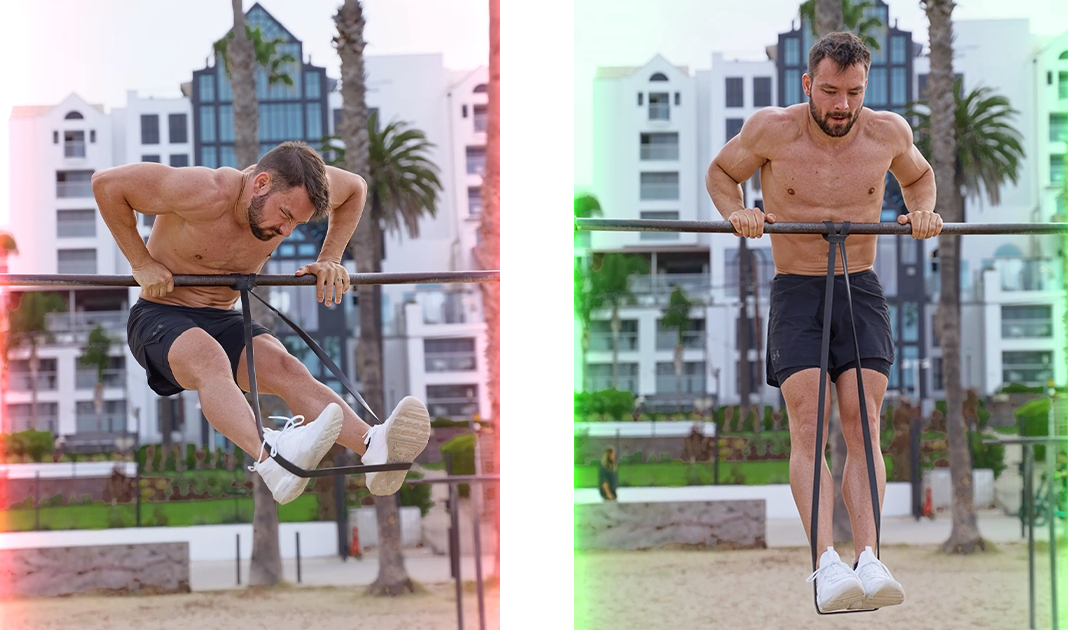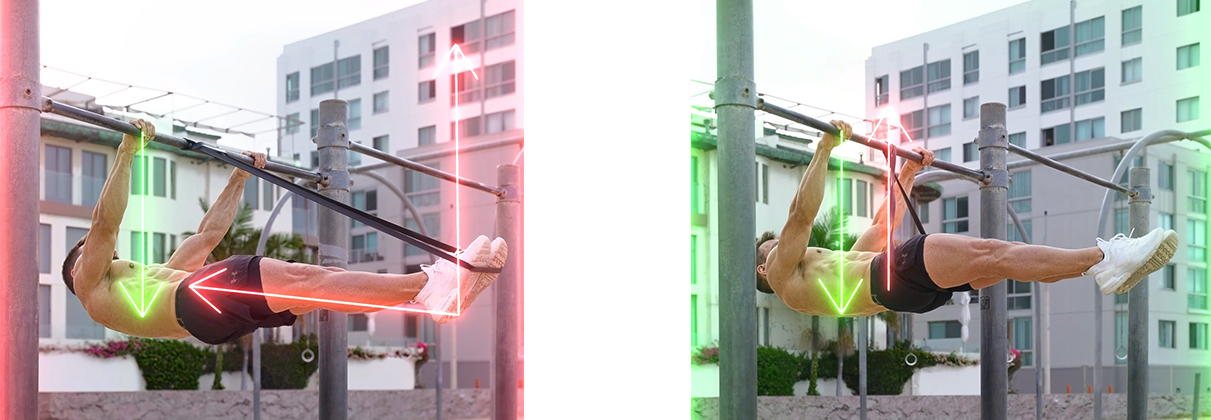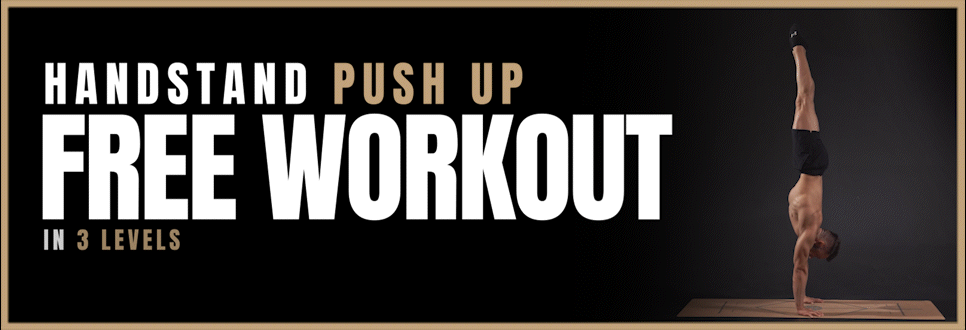Calisthenics and Bands
Why should I train Calisthenics with bands?
There are different occasions on when you should incorporate bands into your training. Gaining this foundational knowledge is the first step towards efficient training and endless gains.
Warm up & Injury Prevention
The most essential use for bands. The one thing that no one ever gets around. Use bands for warm up and prehab work. Make it part of your every day routine. Don’t expect visible results. Simply trust every single health expert or anyone who has been training seriously for 5-10 years and more. Use bands for your daily injury prevention work. It will help you stay healthy and possibly even to get less sore.
Focus especially on external rotation of the shoulder joint. Make sure the band you use is weak. More is not better here! If you load the shoulder too much the small stabilizing muscles that we are trying to target turn off and the main movers activate. A minimum of 12 reps should be performed in every set.
Make skills physically easier
Probably the most difficult thing about advancing in calisthenics compared to regular weight training is that you can not simply add more weight to the bar. In order to regulate the amount of resistance you place on your joints and muscles you have to adjust the angle of your body and possibly place your feet at a certain height. Getting creative this works very well and by now I have found enough progressions to bridge pretty much every single gap even without bands but still, bands can make your live here significantly easier.

You get the opportunity to basically make your muscle 10% or even 20% stronger and with that achieve drills that you would not be able to get just by yourself.
No matter if we are talking about push ups, one arm pull ups or dips. Bands will help you bridge the gap when you are limited by a temporary lack of strength and progressions.
Make things physically harder
On the other hand of the spectrum when we feel stuck on our way to the next progression we don’t always have to make the next goal easier. We can also make the current progression harder by using the band for resistance. Bands are great for that as they mimic the natural movement patterns and functionally of your muscles quite well.
With the help of some creative use of bands you can make pretty much and drill harder. Simply look at the muscle that is doing the main work, analyze in which direction the muscle is working and then install the elastic in the direct opposite. This principle works easily for dips and push ups but can also be applied to back rows or pull ups but attaching the elastic to the floor beneath you.

Improve and fine tune technical details
Another hurdle of advancing in calisthenics is that all drills are compound moves combining strength, technique, direction of engagement and timing. It is usually pretty hard to focus on 1 when everything else needs to happen at the same time as well.
With the help of the elastic you are able to cut strength out of the equation and focus entirely on form. Take planches or levers for example. By allowing the elastic to help you can figure out the exact scapula position to find your perfect alignment for strength and health.
The muscle up is also a great example here. Not only will the elastic give you momentum to teach you when to get your hands and upper body on top of the bar but it will also help you understand the direction of the muscle up. In order to use the elastic to make it up you have to stretch the elastic down and slightly towards the front. Getting efficient with the elastic will also help you to master the swing and tempo of the muscle up.
I could go on for ever but I believe you see my point. Elastic bands are a very practical tool to improve your technique in all calisthenics drills.
Help with balance
No matter if you are working on your pistole squats, single arm elbow lever or one arm handstand, combining strength with balance is never easy. Balancing the position can only work well if you are well aligned and you can only be well aligned if you are strong enough. In very specific cases you can only develop the needed strength by actually doing the drill you are working for. As you can see we have a hard to break cycle. Once again bands are here for our rescue.
When holding on to the wall bars or a simple pole becomes too easy yet you are not able to balance yet without any help using an elastic can be the solution you are looking for. The stronger the elastic and the tighter you install it the closer it’s stability will resemble a pole. Hang the elastic a bit loser and it will start to wobble giving you some assistance but still challenging you to stabilize the position yourself. Like this slowly over time train yourself to go from a pole, to a tight elastic, to a loose one and finally to balance and control without any exterior help.

Reach the needed range
This one is a bit more specific and especially makes sense when it comes to planches. A tuck planche requires significantly less shoulder lean than a straight planche meaning the angle that you are working in is different.
If you want to be able to hold a straight planche you need to be training with the shoulder lean of a straight planche. The elastic can assist you with that to prepare your body very specifically for the pressure in the right angle.
Yet, please do not see this as an opportunity to skip easier progression telling yourself that you don’t need to be able to hold a tuck planche as the straight planche requires your muscles to work in a different range. Please still invest in your tuck planche first and work your way through all progressions. It is absolutely necessary.
Isolation Work
Last but not least we have isolation work which needs to represent a significant part of your weekly routine. Almost every single drill we do when training calisthenics is a compound move. This means that we use multiple muscles or even all muscles of the body at the same time. Whilst I believe this is what we all love about calisthenics it also adds an additional layer of inconvenience to your training.
Isolation work is essential to stay well balanced. Certain muscles like for example the biceps or anterior deltoids are used significantly more than other during a regular calisthenics routine. It is our duty to identify the muscles that are being left behind and to focus our training specifically on them. Having a well balanced body where all muscles get developed equally is one of the foundational pillars of health. Keep in mind that not all muscles develop at the same speed. Even with a perfectly balanced training routine some muscles will fall behind others. It is your duty to identify your personal weak spots and to work on them.
Isolation work is not just great for overall health but also needed when working for more advanced drills. Let’s use the tuck planche as an example. You might be strong enough to hold the position but you realize that after a second or 2 your shoulders collapse and you can not hold your protraction. You can use bands to perform a couple of isolated protraction sets against the elastic at the end of your sessions to get the extra burn where you need it the most.
When working on isolation with bands we have 2 separate approaches.
1 is to use the bands like cable pully systems at the gym to do exercises such as triceps extensions, flies, curls, raises and much more.
The other way is to use bands to make skills easier to be able to focus on the isolated muscle. For example in the front lever, we can use bands to make the shape significantly easier to focus on the protraction of the scapula exclusively.
Either way. Both are great ways to further improve your bodies muscular development, coordination and health. Whilst the second method is for more advanced athletes isolation work in any way should be a part of every single training session.
How to use bands when training Calisthenics?
Use bands to support the working muscle
When setting the bands up the intension should not be to make the goal work no matter how but to support the working muscle and to shift load from the muscle into the band. The ideal scenario would be for the muscle to still work in exactly the same direction but with a couple % less load on it.
For this you have to analyze the exercise. You have to analyze how the body is woking in a skill. As a rule of thumb simply try to counter work gravity when placing the band.
Find your center and pull straight up from there. Gravity only pulls you downward so the elastic should if possible never pull in an angle either.

Use bands when you are almost able without
Bands should only be added to your workout when it actually makes sense. We don’t want to add bands to gain super human strength and to do things completely out of our reach. This might be fun but so is playing catch with my dog. Just unfortunately neither will help you get better at gymnastics strength.
The bands should be used as a final push towards your next progression only.

Don’t train exclusively with bands
Whilst training with bands is fun because you can do more than without and the added bit of strength can be quite satisfying it is important that this new strength is artificial and not real. Use bands as an aid when needed and not for all exercises in your every day training. You want to get good at bodyweight strength moves and not at training with the elastic bands.
Yes, you will build strength when working with bands but your training has to stay specific towards your goals.
It doesn’t have to be perfect
This one is probably the most important part about training with bands. You do not have to find the perfect set up. Considering mechanics when using elastics is great but keep in mind there is no point in chasing perfection.
As long as a drill challenges you and you can perform it clean it is the right drill for you. Don’t try to fix something if it’s not broken. We tend to fall into a pattern of constantly trying to optimize our gains and training routine.

How to attach the bands
When attaching bends definitely put safety first as always. If you question if your set up is safe it most likely is not. Make sure what ever you tie the elastic to is solid. A metal railing or pole is usually best. Applied pressure through the elastic can be quite big. You want to make sure what ever the elastic is attached to can not break in half, move or rotate away.
Also make sure the elastic can not slide off as it can snap back and whiplash you hard.
Always check your set up before starting your next set. Search your band for micro tears on a regular basis to avoid it ripping half way through your set. The more you use an elastic the more likely it becomes to rip. Try not to expose your bands to extreme temperatures and keep them away from the zippers of your training bags.
Different types of bands
There are 2 types of elastics to consider when training calisthenics.
Looped rubber bands and traditional elastic bands.
Looped rubber bands are quite a bit thicker than the traditional bands, they provide more resistance and are therefore great to provide support during drills as they are often strong enough to support almost your entire body weight.
Traditional bands on the other hand are simply long bands. They are significantly weaker and mainly used for warm up and injury prevention. Quality of the band is quite important here to mimic your natural muscle patterns as closely as possible. You want to feel an even stretch that returns back to normal when relaxing the band.
All elastics come in different colors representing different levels of resistance/support. Keep in mind that these colors are NOT universal meaning some manufactures might make red ones the strongest whilst others will decide to make the black ones the toughest. These colors can also not represent precise amounts of resistance as the bands weaken over time due to the repeated stretching of the fabric.
Training routines build exclusively around calisthenics come with a wide variety of problems. If elastic bands are used in a smart and efficient manner as described in the above text you can take care of almost all obvious limiting points of such workout protocols. Keep in mind that your body is specific and just because something works for the guy besides you it doesn’t mean it will work for you. Analyze, adapt and overcome your obstacles.







